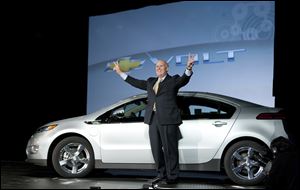
Akerson making big impact at GM
CEO's strategy during safety inquiry 'out of the box'
12/11/2011
Daniel F. Akerson stands near a Chevy Volt in Detroit. Since taking over GM in 2010, Mr. Akerson has led the firm through turbulence, but he faces challenges ahead.
DETROIT -- Late last month, the top executives of General Motors Co. convened for an emergency conference call. The topic: How to respond to a federal investigation of GM's pride and joy, the Chevrolet Volt plug-in hybrid.
GM's chief executive, Daniel F. Akerson, led the talks from his home in Virginia, where his family had gathered for Thanksgiving. This was his first big crisis in 15 months as leader of the nation's largest automaker, and he wanted to act quickly.
"This could be a defining moment for us," he said, according to one participant on the call.
After debating their options, the executives decided to publicly defend the Volt's safety and take the unusual step of offering free loaner cars to owners during the government's inquiry into possible postcrash fires in the Volt's lithium-ion battery.
It was an aggressive -- and potentially risky -- strategy for any car company in the midst of a safety inquiry. "It was very much out of the box," said one analyst, Joseph Phillippi of the firm Auto Trends.
The inbred car culture of Detroit has been shaken up quite a bit in recent years. Alan Mulally left the aircraft maker Boeing to instill fresh thinking at Ford Motor Co., and Sergio Marchionne, the Italian-Canadian head of Fiat, has brought a new discipline to Chrysler Group LLC.
But neither is having a bigger impact than Mr. Akerson is at GM, where senior executives for generations adhered to a strict code of conformity and predictability. A 63-year-old former private equity executive, Mr. Akerson is bent on defining himself as anything but a traditional auto executive.
"He is a very impatient guy," said David Cole, chairman emeritus of the Center for Automotive Research and the son of a former GM president. "But I think he's learning that there is a balance between doing things quickly and understanding how complex this industry is."
The problems with the Volt are a case in point. A few days after the conference call, Mr. Akerson went well beyond the discussion that day and told the Associated Press during a visit to New York that GM was willing to buy back Volts from concerned owners. Back in Detroit, GM officials scrambled to explain the offer as a gesture of good will to its customers, denying that the CEO was setting policy on the fly.
Mr. Akerson has been unavailable to the media since his comments on the Volt. But in a recent interview, he made no apologies for his outspoken style and unconventional approach to managing GM.
He is aware that GM still carries a stigma of being slow and unresponsive. To accelerate decisions, he has eliminated about 30 internal boards and committees. And he is characteristically blunt in describing how GM was run before it was bailed out by the federal government.
"This place lacked a lot of vision," he said in his 39th-floor office at GM headquarters. "They were all over the map. Where was the vision? Where do you want to take this company?"
Since taking the top job in September, 2010, Mr. Akerson has led GM through its public stock offering and guided this summer's successful labor talks with the United Auto Workers.
But he faces many challenges, from finding a fix for the Volt's battery problems to cementing GM's fragile comeback since emerging from its government-financed bankruptcy two years ago.
Despite improving sales and seven straight profitable quarters, GM's stock price is languishing around $20 after going public at $33.
And because U.S. taxpayers still own a 26 percent stake in GM, the company is finding it tough to shed its distasteful image as "Government Motors."
Analysts say that investors are still skittish about GM because its decades-long decline is still fresh.
"People are very sensitive for early warning signs that the 'old GM' is still there," said Brian Johnson of Barclays Capital.
The bankruptcy and federal rescue left GM with a strong balance sheet, about $30 billion in cash, and the chance to improve its products without constantly worrying about financial pressures.
Mr. Akerson is pushing hard to improve GM's brands, notably by expanding the Cadillac lineup and increasing its international sales.
Mr. Akerson also has taken a personal interest in the Volt, challenging engineers to cut $10,000 in costs from the $40,000 car, and bolstering production from 15,000 vehicles this year to 60,000 in 2012.
Inside GM, his decisive personality has taken some getting used to.
His methods were often contrasted to those of Rick Wagoner, GM's longtime chief executive, who was forced out by the Obama Administration in 2009.
"He's a lot tougher than Wagoner," said one executive, who spoke on the condition that he not be named because he was not authorized to speak publicly.